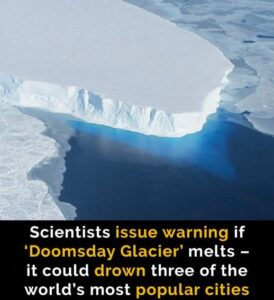“Doomsday Glacier” Meltdown Could Submerge Iconic Cities as Collapse Risk Grows

A massive ice formation in Antarctica, ominously known as the “Doomsday Glacier,” is drawing urgent concern from scientists who now believe its potential collapse is becoming increasingly likely—and could have catastrophic effects on coastal cities around the globe.
Formally known as Thwaites Glacier, this vast frozen mass in West Antarctica holds enough ice to raise global sea levels by more than two feet on its own. But researchers warn that a total collapse wouldn’t stop there. It could destabilize neighboring ice structures, unleashing a domino effect that raises ocean levels by as much as 10 feet. Such a surge would put major metropolitan areas—including New York City, London, and Bangkok—underwater.
The latest findings, highlighted by BBC Science Focus, stem from new studies conducted by the International Thwaites Glacier Collaboration (ITGC). In early 2025, Professor Noel Gourmelen and his team revealed that the drainage of subglacial lakes beneath Thwaites is playing a far more dramatic role than previously understood.
“We knew subglacial water influenced melting, but witnessing this level of drainage was unprecedented,” said Gourmelen. “It effectively supercharged the glacier’s retreat, accelerating ocean-driven melting at its most vulnerable flank.”

This “supercharging” effect is made worse by record-breaking heat in the Southern Hemisphere this year, which has caused alarm within the scientific community. With ocean temperatures higher than projected and Antarctica’s climate shifting rapidly, experts say we may be closer to a critical tipping point than ever imagined.
Dr. Alastair Graham, a marine geologist from the University of South Florida and fellow ITGC member, described 2025 as a game-changing year for glacial stability.
“Thwaites alone could add about 65 centimeters—roughly 25 inches—to sea levels if it gives way,” Graham noted. “But this year’s heat has pushed us into a different reality. The system may no longer be able to recover seasonally. We’re seeing real signs of structural weakness.”
Although a total collapse might still be decades or even centuries off, scientists now say it’s no longer safe to assume that such a future lies comfortably in the distant timeline. If current warming trends continue, the glacier’s weakening could become irreversible far sooner.
Beyond environmental devastation, a sea-level rise of even a few feet would devastate global economies, displace millions of people, and reshape coastlines permanently.
The warning from the scientific community is stark: the time to act is now. Without rapid, large-scale action to curb greenhouse gas emissions and mitigate warming, the world could face a watery reckoning—with iconic cities and entire nations paying the ultimate price.